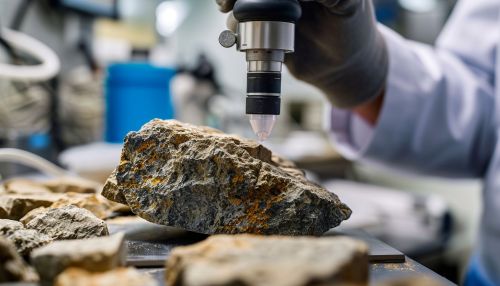Isotope Geochemistry
Introduction
Isotope geochemistry is a specialized field within the broader discipline of geochemistry, which focuses on the study of the relative and absolute concentrations of the elements and their isotopes in the earth. This field utilizes the unique properties of stable and radioactive isotopes to understand the age, origin, and history of rocks, minerals, and fluids within the earth's crust, mantle, and core.


Principles of Isotope Geochemistry
Isotope geochemistry relies on the principle that isotopes of a particular element exhibit identical chemical behavior but different physical behavior. This difference in physical behavior is due to the variance in the number of neutrons in the nucleus of the isotopes. Consequently, isotopes can be used as tracers or chronometers to understand geological processes.
Isotopic Tracers
Isotopic tracers are used to track the movement and interaction of elements within geological systems. For instance, the isotopes of hydrogen, oxygen, and carbon are commonly used to trace the movement of water and carbon dioxide in the environment. The isotopic composition of these elements can reveal information about the source, pathway, and age of these substances.
Isotopic Chronometers
Isotopic chronometers, on the other hand, are used to determine the age of rocks and minerals. This is achieved by measuring the ratio of parent isotopes to daughter isotopes in a sample. The most commonly used isotopic chronometer is the radiometric dating method, which uses the decay of radioactive isotopes like uranium-238, thorium-232, and potassium-40.
Stable Isotopes in Geochemistry
Stable isotopes are those that do not undergo radioactive decay. They are particularly useful in isotope geochemistry because they can provide information about the temperature at which a mineral formed, the source of fluids in a rock, or the diet of an ancient organism. Examples of stable isotopes commonly used in geochemistry include carbon-13, nitrogen-15, and oxygen-18.
Radiogenic Isotopes in Geochemistry
Radiogenic isotopes are the isotopes formed by the decay of a radioactive parent isotope. They are used extensively in isotope geochemistry for dating rocks and minerals and tracing the source of certain elements. Examples of radiogenic isotopes include strontium-87 (from the decay of rubidium-87) and lead-206 (from the decay of uranium-238).
Applications of Isotope Geochemistry
Isotope geochemistry has a wide range of applications in earth sciences, environmental sciences, archaeology, and even forensic science. Some of the key applications include:
Dating Rocks and Minerals
As mentioned earlier, one of the primary applications of isotope geochemistry is in the dating of rocks and minerals. This is achieved through radiometric dating techniques, which measure the ratio of parent to daughter isotopes in a sample.
Tracing Geological Processes
Isotope geochemistry is also used to trace geological processes such as magma mixing, crustal contamination, and mantle-crust interaction. For instance, the isotopic composition of lead, strontium, and neodymium can provide information about the source of magma and the degree of crustal contamination.
Environmental Studies
In environmental studies, isotope geochemistry is used to trace the movement of pollutants in the environment, understand the global carbon cycle, and study climate change. For instance, the isotopic composition of carbon in atmospheric carbon dioxide can provide information about the sources and sinks of carbon dioxide.
Archaeology and Forensics
In archaeology and forensics, isotope geochemistry is used to determine the diet and migration patterns of ancient humans and animals. For instance, the isotopic composition of carbon and nitrogen in bone collagen can provide information about the diet of an individual, while the isotopic composition of strontium and oxygen can provide information about the geographical origin and migration patterns.
